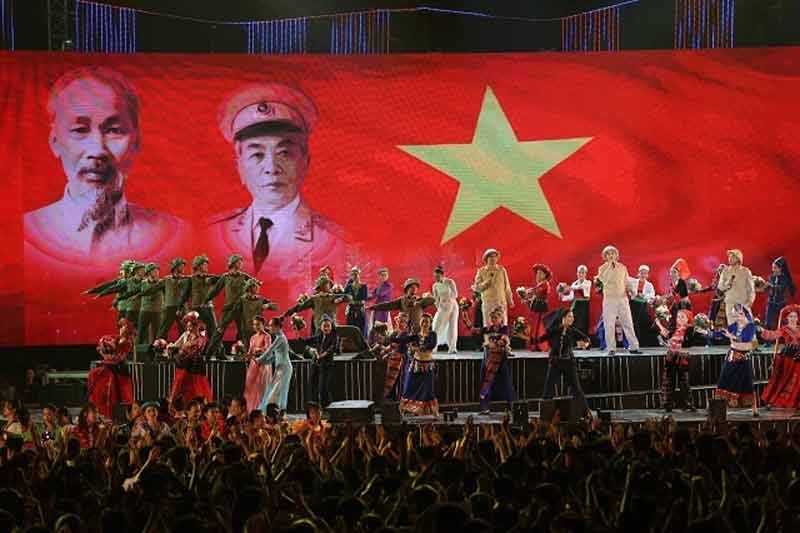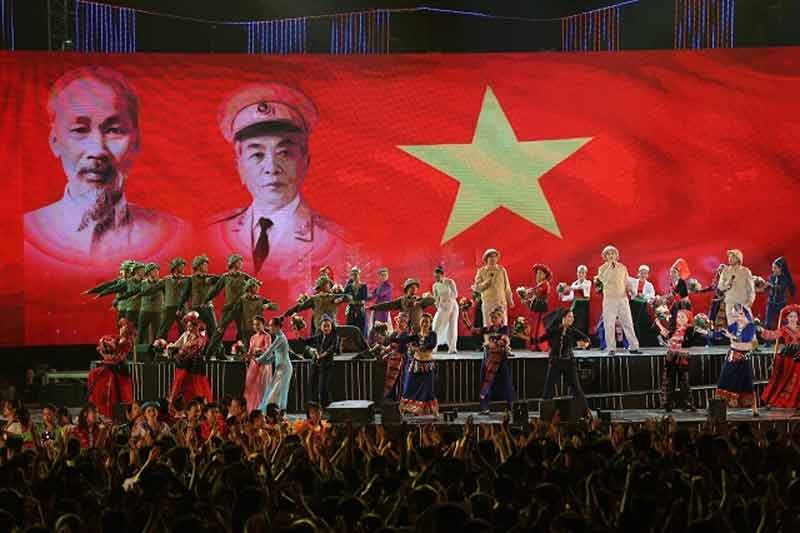
An art programme was held at May 7 Square, Dien Bien Phu city, to celebrate the 65th anniversary of the resounding Dien Bien Phu Victory (May 7, 1954 – May 7, 2019).
The
event was attended by Politburo member and Permanent Vice Chairwoman of the
National Assembly Tong Thi Phong; Politburo member, Secretary of Party Central
Committee (PCC) and Head of the PCC’s Commission for Communication and
Education Vo Van Thuong; and member of the Party Central Committee and
Secretary of the Dien Bien provincial Party Committee Tran Van Son, along with
many other leaders of the province, as well as hundreds of veterans who participated
in the Dien Bien Phu campaign.

Art programme celebrates Dien Bien Phu victory.
The programme helps audiences
look back at the milestones of Dien Bien Phu from 65 years ago through a
combination of current experiences and reminiscing on the past, art and
analysis. The programme brought many emotions and impressions to the hearts of
audiences as well as Dien Bien people, especially former Dien Bien soldiers.
For the first time, the
programme created a historic rendezvous for Vietnamese and French, who meet
through memories and connect with each other through the experiences of the
present.
Through the stories in the
programme, the generations of descendants, who have never gone through war,
have an opportunity to understand the values of the nation and of peace.
With an increasingly vibrant and widespread emulation movement aimed at building cultured residential areas and cultured families, Yen Thuy District has been making steady progress toward improving both the material and spiritual well-being of its people, while fostering a civilized, prosperous, beautiful, and progressive community.
Once lacking recreational spaces and community facilities, Residential Group 2 in Quynh Lam Ward (Hoa Binh City) has recently received attention for the construction of a new, spacious, and fully equipped cultural house. The project followed the model of state support combined with public contributions in both labor and funding.
The "All people unite to build cultural life" movement, which has been effectively integrated with Kim Boi district’s socio-economic development goals, is fostering a lively spirit of emulation across local residential areas, hamlets, villages, public agencies, and enterprises. In addition, through the initiative, traditional cultural values are being preserved and promoted, while community solidarity and mutual support in poverty reduction and economic development are being strengthened.
A working delegation of the Hoa Binh provincial People’s Committee led by its Permanent Vice Chairman Nguyen Van Toan on June 11 inspected the progress of a project to build the Mo Muong Cultural Heritage Conservation Space linked to tourism services in Hop Phong commune, Cao Phong district.
Born and growing in the heroic land of Muong Dong, Dinh Thi Kieu Dung, a resident in Bo town of Kim Boi district, in her childhood was nurtured by the sweet lullabies of her grandmother and mother. These melodies deeply imprinted on her soul, becoming an inseparable part of her love for her ethnic group's culture. For over 20 years, this love for her hometown has driven Dung to research, collect, and pass down the cultural values of the Muong people to future generations.
In the final days of May, the Ethnic Art Troupe of Hoa Binh Province organized performances to serve the people in remote, mountainous, and particularly disadvantaged areas within the province. These were not just ordinary artistic shows, but they were the meaningful journeys aimed at spreading cultural values, enhancing the spiritual life of the people and contributing to the preservation of ethnic minority cultural identities.



